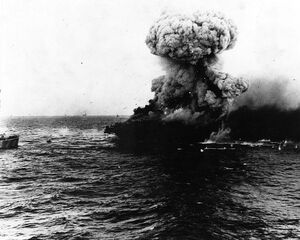
|
This Yellowstone: 1936 page is a Proposal.
It has not been ratified and is therefore not yet a part of the Yellowstone: 1936 Timeline. You are welcome to correct errors and/or comment at the Talk Page. If you add this label to an article, please do not forget to make mention of it on the Main Discussion page for the Timeline. |
| Battle of the Coral Sea | |||||||
|---|---|---|---|---|---|---|---|
| Part of the Pacific War | |||||||
 Allied aircraft carrier USS Lexington explodes on 14 May 1939, several hours after being damaged by a Japanese carrier air attack. |
|||||||
|
|||||||
| Belligerents | |||||||
| Commanders and leaders | |||||||
| Frank J. Fletcher Thomas C. Kinkaid Aubrey Fitch George Brett | |||||||
The Battle of the Coral Sea, fought during 10–14 May 1939, was a major naval battle in the Pacific War between the Imperial Japanese Navy and naval and air forces from the US Pacific-Asiatic Zone and Australia. The battle was the first action in which aircraft carriers engaged each other, as well as the first in which neither side's ships sighted or fired directly upon the other.
In an attempt to strengthen their defensive positioning for their empire in the South Pacific, Japanese forces decided to invade and occupy Port Moresby in New Guinea and Tulagi in the southeastern Solomon Islands. The plan to accomplish this, called Operation MO, involved several major units of Japan's Combined Fleet, including two fleet carriers and a light carrier to provide air cover for the invasion fleets, under the overall command of Japanese Admiral Shigeyoshi Inoue.
On 9–10 May, Japanese forces successfully invaded and occupied Tulagi, although several of their supporting warships were surprised and sunk or damaged by aircraft from the Allied fleet carrier Ranger. Now aware of the presence of Allied carriers in the area, the Japanese fleet carriers entered the Coral Sea with the intention of finding and destroying the Allied naval forces.
Beginning on 11 May, the carrier forces from the two sides exchanged airstrikes over two consecutive days. The first day, the American fleet sank the Japanese light carrier Shōhō, while the Japanese sank an Allied destroyer and heavily damaged a fleet oiler (which was later scuttled). The next day, the Japanese fleet carrier Shōkaku was heavily damaged, the American fleet carrier Lexington was critically damaged (and was scuttled as a result), and the Ranger was damaged. With both sides having suffered heavy losses in aircraft and carriers damaged or sunk, the two fleets disengaged and retired from the battle area. Because of the loss of carrier air cover, Inoue recalled the Port Moresby invasion fleet, intending to try again later.
Although a tactical victory for the Japanese in terms of ships sunk, the battle would prove to be a strategic victory for the Allies for several reasons. Japanese expansion, seemingly unstoppable until then, was turned back for the first time. More importantly, the Japanese fleet carriers Shōkaku and Zuikaku – one damaged and the other with a depleted aircraft complement – were unable to participate in the Battle of Midway, which took place the following month.
| ||||||||||||||||||||||
| ||||||||||||||||||||
